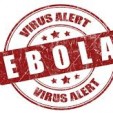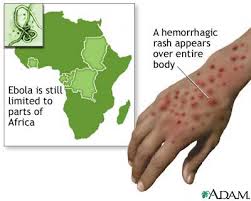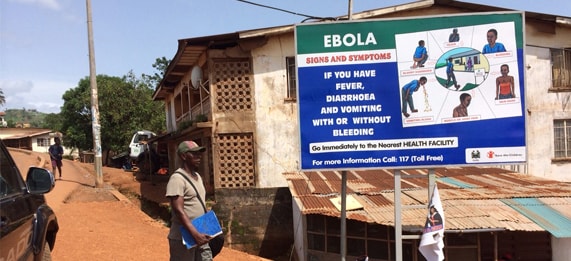
Ebola Outbreak in Guinea, Liberia, and Sierra Leone
About Ebola Hemorrhagic Fever
Ebola hemorrhagic fever (Ebola HF) is one of numerous Viral Hemorrhagic Fevers. It is a severe, often fatal disease in humans and nonhuman primates (such as monkeys, gorillas, and chimpanzees). Ebola HF is caused by infection with a virus of the family Filoviridae, genus Ebolavirus. When infection occurs, symptoms usually begin abruptly. The first Ebolavirus species was discovered in 1976 in what is now the Democratic Republic of the Congo near the Ebola River. Since then, outbreaks have appeared sporadically. There are five identified subspecies of Ebolavirus. Four of the five have caused disease in humans: Ebola virus (Zaire ebolavirus); Sudan virus (Sudan ebolavirus); Taï Forest virus (Taï Forest ebolavirus, formerly Côte d’Ivoire ebolavirus); and Bundibugyo virus (Bundibugyo ebolavirus). The fifth, Reston virus (Reston ebolavirus), has caused disease in nonhuman primates, but not in humans. The natural reservoir host of ebolaviruses remains unknown. However, on the basis of available evidence and the nature of similar viruses, researchers believe that the virus is zoonotic (animal-borne) with bats being the most likely reservoir. Four of the five subtypes occur in an animal host native to Africa. A host of similar species is probably associated with Reston virus, which was isolated from infected cynomolgous monkeys imported to the United States and Italy from the Philippines. Several workers in the Philippines and in US holding facility outbreaks became infected with the virus, but did not become ill.
Transmission
Transmission Because the natural reservoir of ebolaviruses has not yet been proven, the manner in which the virus first appears in a human at the start of an outbreak is unknown. However, researchers have hypothesized that the first patient becomes infected through contact with an infected animal. When an infection does occur in humans, there are several ways in which the virus can be transmitted to others. These include: direct contact with the blood or secretions of an infected person exposure to objects (such as needles) that have been contaminated with infected secretions The viruses that cause Ebola HF are often spread through families and friends because they come in close contact with infectious secretions when caring for ill persons. During outbreaks of Ebola HF, the disease can spread quickly within health care settings (such as a clinic or hospital). Exposure to ebolaviruses can occur in health care settings where hospital staff are not wearing appropriate protective equipment, such as masks, gowns, and gloves. Proper cleaning and disposal of instruments, such as needles and syringes, is also important. If instruments are not disposable, they must be sterilized before being used again. Without adequate sterilization of the instruments, virus transmission can continue and amplify an outbreak.
Signs and Symptoms
Symptoms of Ebola HF typically include:Fever, Headache, Joint and muscle aches, Weakness, Diarrhea, Vomiting, Stomach pain, Lack of appetite. Some patients may experience: A Rash, Red Eyes, Hiccups, Cough, Sore throat, Chest pain, Difficulty breathing, Difficulty swallowing, Bleeding inside and outside of the body. Symptoms may appear anywhere from 2 to 21 days after exposure to ebolavirus though 8-10 days is most common. Some who become sick with Ebola HF are able to recover, while others do not. The reasons behind this are not yet fully understood. However, it is known that patients who die usually have not developed a significant immune response to the virus at the time of death.
Risk of Exposure
Risk of Exposure Risk of Exposure In Africa, confirmed cases of Ebola HF have been reported in: Guinea Liberia Sierra Leone Democratic Republic of the Congo (DRC) Gabon South Sudan Ivory Coast Uganda Republic of the Congo (ROC) South Africa (imported) The natural reservoir host of ebolaviruses, and the manner in which transmission of the virus to humans occurs, remain unknown. This makes risk assessment in endemic areas difficult. With the exception of several laboratory contamination cases (one in England and two in Russia), all cases of human illness or death have occurred in Africa; no case has been reported in the United States. During outbreaks of Ebola HF, those at highest risk include health care workers and the family and friends of an infected individual. Health care workers in Africa should consult the Infection Control for Viral Hemorrhagic Fevers In the African Health Care Setting to learn how to prevent and control infections in these setting. Medical professionals in the United States should consult the
Interim Guidance for Managing Patients with Suspected Viral PDF file [PDF – 60KB
Content source: Centers for Disease Control and Prevention
National Center for Emerging and Zoonotic Infectious Diseases (NCEZID)
Division of High-Consequence Pathogens and Pathology (DHCPP)
Read the LATEST NEWS HERE at Centers for Disease Control and Prevention




